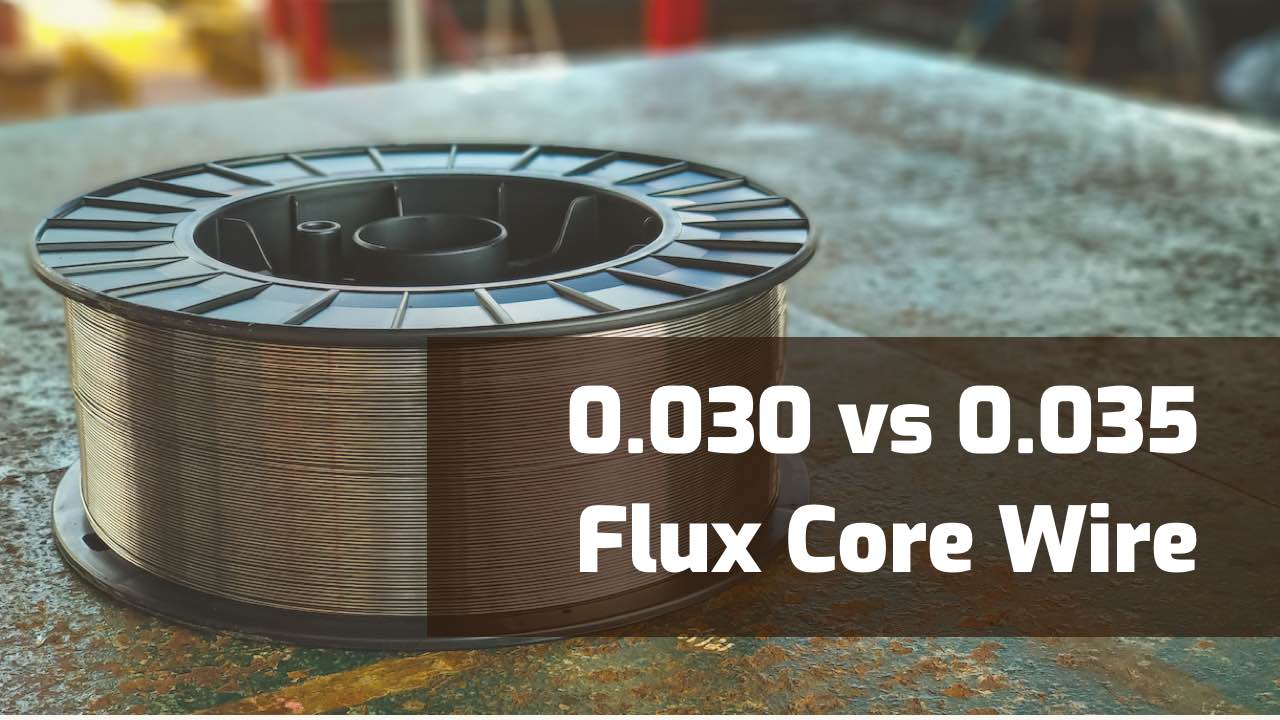There isn’t a major difference between the 0.030 and 0.035 flux-cored wires. But each is more suited for specific applications.
These differences mainly revolve around the thickness of the material, welding machine abilities, and the specific use cases where one may be better than the other.
In this article, you’ll learn which wire is better in certain situations. As a bonus, you might even discover a thing or two about flux-cored wires in general.
What is Flux-Cored Wire?
A flux-cored wire is essentially a tube packed with a flux substance in its core. It’s like a stick electrode turned inside out.
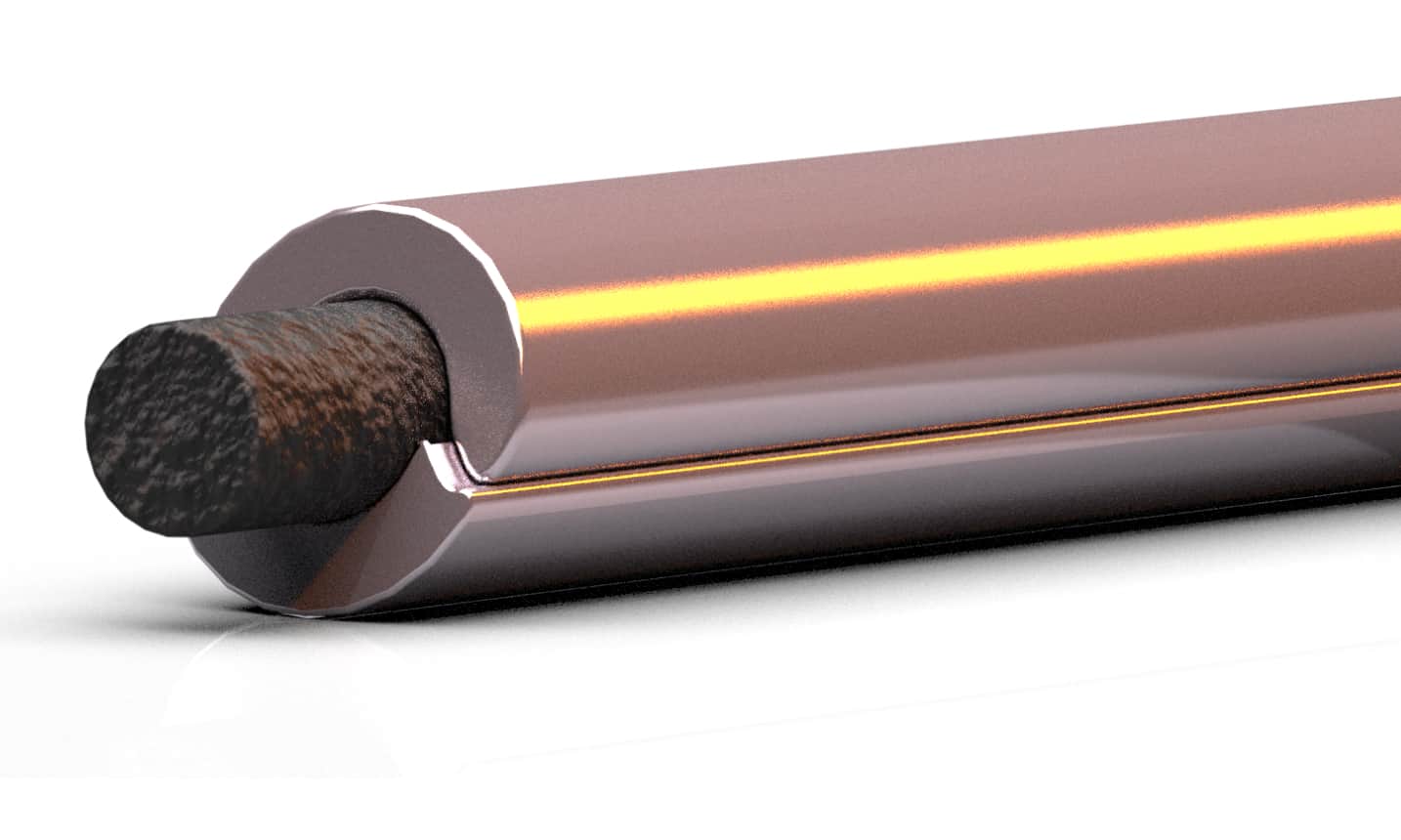
Credit: weldnotes.com
This flux is a compound mixture of alloys and deoxidizers that allow users to weld dirtier metal and it be used in windy conditions.
Flux generates shielding gasses when flux-core welding, which protects the molten weld pool from oxygen and nitrogen and stabilizes the arc. It also collects the impurities in a slag layer on top of the bead, which is chipped off after the weld cools down.
The deoxidizers found in cored wires are typically aluminum and magnesium. Once exposed to gasses in the atmosphere, deoxidizers form aluminum oxide, aluminum nitride, and magnesium oxide.
These newly formed compounds solidify rapidly on the weld surface, protecting the bead from atmospheric contamination.
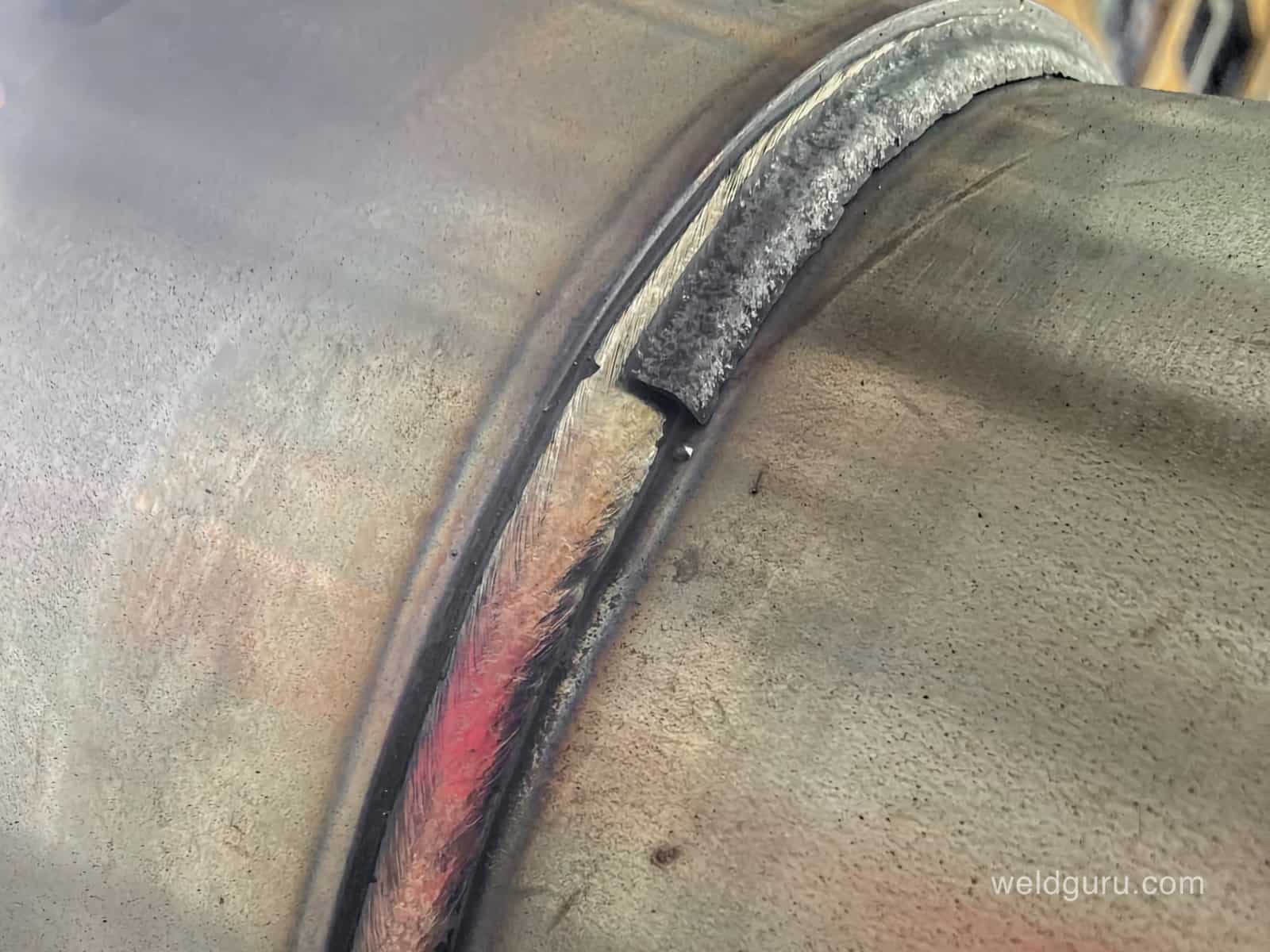
Effectively, the two typical weld contaminants (oxygen and nitrogen) transform into protective compounds. That’s why no shielding gas is necessary when using a flux-cored wire. This applies only to self-shielded flux-cored wires (FCAW-S), which most people use.
Read more: What is Flux in welding & What is it used for?
These wires are available in different diameters, including 0.030” and 0.035”. In addition, they can be used in all positions or flat/horizontal only.
Cored wires are typically manufactured by taking a thin steel strip and rolling it in a “U” shape. Flux is poured into the cavity, and the seam is tightly rolled closed.
The seam can be either a lap or a butt joint. The lap joint is somewhat more secure against moisture contamination.
The outer tube of the wire is called the “jacket” or “sheath,” while the mixture inside is called the “flux-core.”
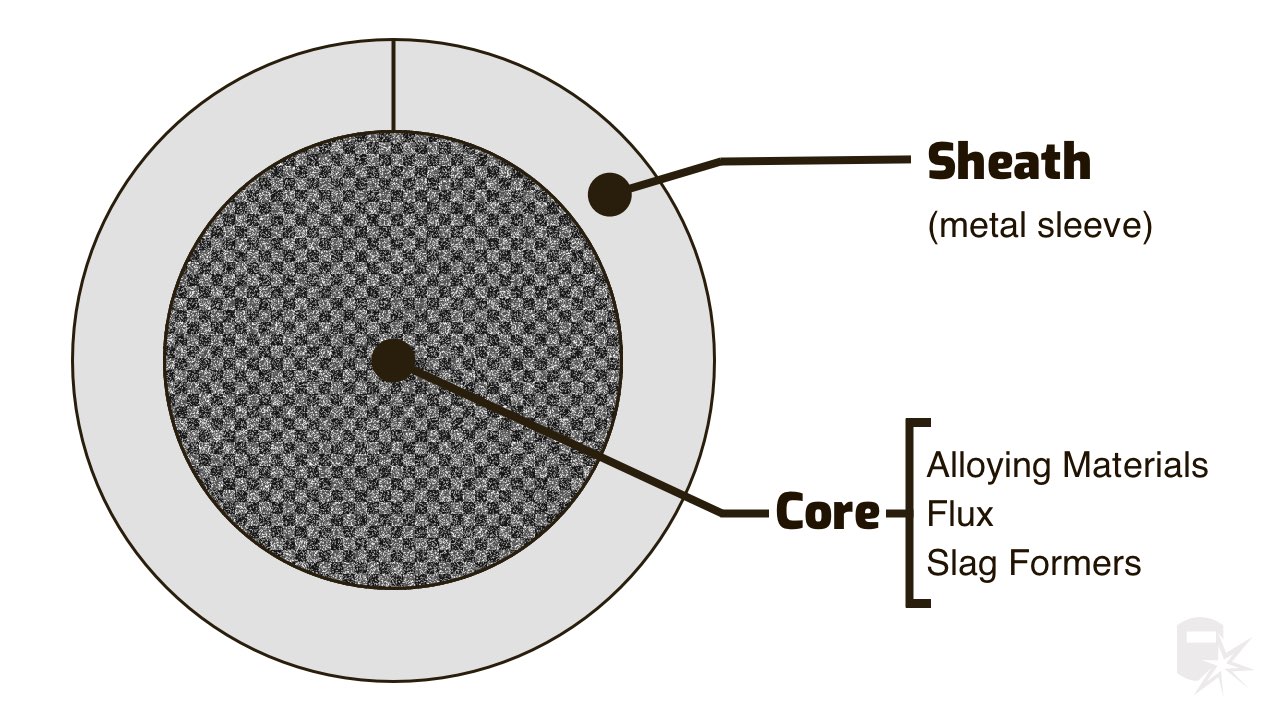
Most cored wires are designed to work with direct current electrode negative (DCEN), which is the opposite of solid steel MIG wires. So, you will have to switch polarity between your MIG gun and the ground clamp when changing over to flux-cored wire.
0.030 vs. 0.035 – Which One Should You Use?
Side-by-Side Comparison
Using general metrics, let’s compare these two diameter flux-cored wires side by side.
It’s difficult to compare real-world products because most of them don’t provide the necessary data.
| Feature | 0.030” | 0.035” |
|---|---|---|
| Material Thickness Range Single Pass (mild steel) | 22 Gauge (.031”) 14 Gauge (.078”) | 20 Gauge (.037”) 3/16” (.188”) |
| Required Volt Range * | 17-20V | 18-24V |
| Wire Feed Speed Range * | 170-215 IPM | 170-350 IPM |
| Smoke and Spatter Amount | Less | More |
| Amount of Shielding Flux | Less | More |
| Wire Stick-out | Shorter | Longer |
| Recommendation | 0.030 for mild steel | 0.035 for mild steel |
Let’s dig in a little deeper to explore the differences between these two cored wire thicknesses in real-world examples.
I will explain both wires in a general manner. But be aware that specific brands can provide different results.
The chemical compounds and manufacturing processes vary between different production plants.
0.030 Flux-Cored Wire
The 0.030” diameter flux-cored wire is a typical hobbyist-level wire meant for thinner metal. It’s primarily used for light welding work outdoors or by people who don’t want to bother with the whole MIG shielding gas setup.
It will weld anything between 22 gauge and 14 gauge thick. You can even try 24 gauge, but it can lead to burn-through. Welding thicker than 14 gauge is possible with multiple passes, but only if the wire is designed for it.
This wire will perform best if you use it with 210V input. It also works fine at 120V, but you should use a higher voltage to burn it hot and get the best penetration.
So, let’s take a look at Lincoln’s Innershield NR-211MP (AWS – E71T-11), one of the top-rated, standard 0.030” cored wires for all position welding.
The first thing to note is that its spec sheet says explicitly that all diameters under 0.045” can’t weld above 5/16”. That means that you can’t weld thicker with the 0.035”. If you spend a few hours reading through various Lincoln Electric documents on their website, you’ll find that this is because of the generated heat.
If you weld metal thicker than recommended, the chill rate of the weld will be too fast for the wire’s design. The high thermal conductivity of the thicker base metal induces rapid cooling, which leads to cracks thanks to brittleness caused by weld quenching.
However, 0.030” wire produces less smoke and spatter thanks to its lower amount of flux. Additionally, the thinner flux, and tubular steel walls, require less amperage and voltage for maximum heat. So, a weaker machine will run them slightly better than the 0.035”.
Suppose your welder is not very powerful. In that case, the 0.030” will conduct voltage better, and the arc will have a more stable behavior. Cored wires are very sensitive to voltage fluctuations.
Conversely, the 0.035” wire requires slightly more voltage, which if not provided, will lead to arc cone shortening and reduction of the bead’s width.
This can lead to burn-though or poor penetration depending on your metal and welder’s amperage output.
The 0.030” is also a good choice when welding in tight corners because you’ll deposit less metal and be able to see the weld pool more clearly. It is also cheaper and gives you more wire length per pound.
0.035 Flux-Cored Wire
The 0.035” cored wire offers slightly more welding power, provides a higher heat input into the metal, and better penetration.
Compared to the 0.030” this thicker diameter is used in similar environments. But with a higher flux content, it can better withstand windy conditions. That’s why a 0.035” wire produces better results when welding outside. Depending on the wind strength and arc quality, the 0.030” wire may not prevent all of the oxygen and nitrogen from weld contamination.
This wire can weld a maximum of 3/16” and down to 20 gauge steel as a minimum. Since it applies more heat to the metal, you are unlikely to weld anything thinner than the recommended 20 gauge.
To get the most out of this diameter, you should use a machine with 250V input. It can work well with less voltage, too. But, poor cable connections, long power cables, undersized cables, poor welding clamps, and the efficiency power rating of the welder will all chip away at the available voltage. So, if you want to run it hot for maximum penetration, it needs a high voltage input.
If we look at Hobart’s 0.035” E71T-11 cored wire, we’ll see that they don’t provide as many specs as Lincoln. In such cases, it’s best to stick to the recommended thicknesses I talked about above.
Hobart’s wire allows for multi-pass welds, galvanized steelwork, and all-position welding like Lincoln’s.
But this wire has a higher aluminum and a lower manganese content, making Lincoln’s wire a better choice. A higher manganese content refines weld microstructures and promotes acicular ferrite formation.
The study from 1980 by the American Welding Society (AWS) found that the increased presence of manganese increases both tensile strength and yield strength.
However, the same study found that strain aging significantly affects the notch toughness when higher manganese content is present.
This means that any flaw in the weld, like a notch or a crack, is less likely to sustain stress under load when using this Hobart wire.
So, while Lincoln’s wire is a bit better, it needs a perfect weld bead for its high manganese content to make a difference.
The 0.035” produces more smoke and welding spatter due to the additional flux and steel content.
So, if you are looking for a cleaner weld, you should use 0.030” when possible. But unlike the 0.030”, the 0.035” will deposit more metal and makes for a better choice when welding gaps.
Smaller-diameter wires require less stick-out, so the 0.035” is better if you are still learning. A bigger stick out gives you more oversight of the bead because the tip is not as close to the weld pool.
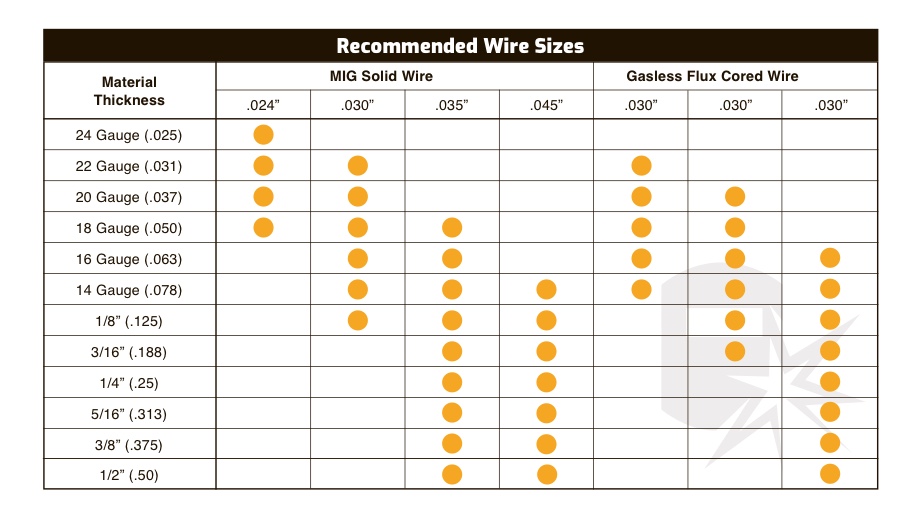
Wrapping It Up
There are subtle differences between these two “flavors” of flux-cored wire. Knowing what they are can help you know which to use in certain situations resulting in better quality welds.
But if you are a hobbyist welder, the slight variation in these two different diameter flux-cored wires will not make a huge difference. You are more likely to experience problems if using a poor-quality wire.
However, as you’ve seen, these wires do have their differences. If welding something delicate, even as a hobbyist, you can benefit from a proper wire selection. I hope that this article helps you do just that.
If it did, please share it with your welder friends. These nuances are rarely discussed on the internet, so maybe they’ll learn something new.
Need more tips? Read these flux core welding tips and tricks for beginners.
